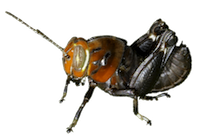Family (Alpha): ACRIDIDAE GRYLLACRIDIDAE GRYLLIDAE GRYLLOTALPIDAE RHAPHIDOPHORIDAE ROMALEIDAE TETRIGIDAE TETTIGONIIDAE TRIDACTYLIDAE
View Gryllidae Members:
Acheta domesticus Anurogryllus arboreus Gryllus unidentified species Gryllus firmus Gryllus fultoni Gryllus pennsylvanicus Gryllus pennsylvanicus/veletis Gryllus pennsylvanicus-veletis Gryllus rubens Gryllus veletis Miogryllus verticalis Velarifictorus micado Hapithus agitator Orocharis unidentified species Orocharis luteolira Orocharis saltator Cycloptilum unidentified species Cycloptilum bidens Cycloptilum pigrum Cycloptilum slossoni Cycloptilum tardum Cycloptilum trigonipalpum Cycloptilum velox Myrmecophilus pergandei Allonemobius allardi Allonemobius fultoni Allonemobius griseus griseus Allonemobius griseus funeralis Allonemobius maculatus Allonemobius socius Allonemobius sparsalsus Allonemobius tinnulus Allonemobius walkeri Allonemobius unidentified species Eunemobius carolinus Eunemobius confusus Eunemobius melodius Eunemobius unidentified species Neonemobius cubensis Neonemobius palustris Neonemobius variegatus Pictonemobius ambitiosus complex Pictonemobius ambitiosus Pictonemobius hubbelli Oecanthus unidentified species Oecanthus celerinictus Oecanthus exclamationis Oecanthus fultoni Oecanthus latipennis Oecanthus nigricornis Oecanthus niveus Oecanthus pini Oecanthus quadripunctatus Neoxabea bipunctata Phyllopalpus pulchellus Anaxipha delicatula Anaxipha exigua Anaxipha litarena Anaxipha rosamacula Anaxipha thomasi Anaxipha tinnula Anaxipha tinnulacita Anaxipha tinnulenta Anaxipha vernalis Anaxipha unidentified species Cyrtoxipha columbiana Falcicula hebardi Gryllidae unidentified species NC Records
Anaxipha exigua (Say, 1825) - Say's Trig
No image for this species.
Taxonomy
Family: Gryllidae
Subfamily: TrigonidiinaeTribe: TrigonidiiniSynonym: Anaxipha pulicaria Comments: One of thirteen species in this genus that occur in North America north of Mexico (SINA, 2017); nine of which have been recorded in North Carolina. Exigua belongs to the Exigua Species Group, which also includes tinnula, thomasi, tinnulacita, and tinnulenta in North Carolina (Walker and Funk, 2014).Species Status: Fulton (1956) described three song types used by members of what was then considered Anaxipha exigua, one of which was later described as tinnulenta by Walker and Funk (2014)
Identification
Field Guide Descriptions: Elliot and Hershberger (2007); Himmelman (2009) Online Photographs: SINA, Songs of Insects, Google Images ,
iNaturalist , GBIF Technical Description, Adults/Nymphs: Walker and Funk (2014)SINA 616a.htm Comments: A very small, brown Trig. Like other members of the exigua group, it possess a broad dark stripe on the lateral face of the femur (Walker and Funk, 2014). Structural features -- particularly the number of pegs on the stridulatory file -- must be examined to identify this species; the song is also distinctive.Total Length [body plus wings; excludes ovipositor]: 5.6-6.7 mm, males; 5.8-8.0 mm, females (Walker and Funk, 2014)Structural Features: "Stridulatory file with about 117 teeth (range 100-135)" (see Walker and Funk, 2014 for additional structural characteristics). Macropterous individuals have been observed but are rare.Singing Behavior: The song is a clear continuous trill with a pulse rate of about 44 pulses per second and the dominant pitch at 7.2 kHz (at 25°C) (Walker and Funk, 2014). Individual pulses are over-slurred and have a pure tonal quality like other members of this genus.Recording playback at normal speed.
Download Video:
"MP4"
Nymphal Stages and Development: Apparently undescribed but unlikely to be distinguishable, particularly from other members of the Exigua Species Groups
Distribution in North Carolina
County Map: Clicking on a county returns the records for the species in that county.
Adult Dates: Click on graph to enlarge
Habitats and Life History
Habitats: Fulton (1956) described the habitat of his trilling form of exigua (now recognized as true exigua) as consisting of deeply shaded mesic to wet forests, becoming most abundant in wet seeps dominated by Lizard Tail. Walker and Funk (2014), however, also include open woods and old fields in addition to riparian areas. They mention that exigua usually occurs in partial shade and is usually found near the ground to about 2 meters above it in coarse weeds or woody plants. Diet: Apparently unrecorded; possibly omnivorousObservation Methods: Singing males are most easily detected but they may also be captured using sweep nettingAbundance/Frequency: Records in North Carolina where numbers are given suggest that males are usually heard singly. Elliot and Hershberger (2007), on the other hand, report finding hundreds of individuals on single small trees.Adult Phenology: Adults appear in late July and persist at least until mid October (Fulton, 1951)
Status in North Carolina
Natural Heritage Program Status: Natural Heritage Program Ranks: GNR [S4S5]State Protection: Has no legal protection, although permits are required to collect it on state parks and other public landsComments: This species has been recorded over a fairly wide area of the state and occupies fairly common types of habitats. Consequently, it is probably secure in the state.
Image Gallery for Anaxipha exigua - Say's Trig Recorded by: Steve Hall Recorded by: Steve Hall Recorded by: Steve Hall Recorded by: Steve Hall

 »
»
 »
»